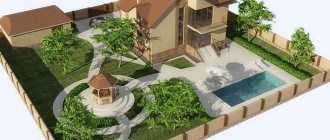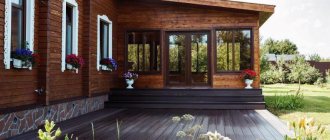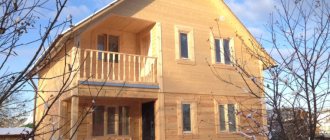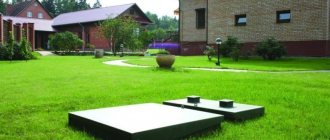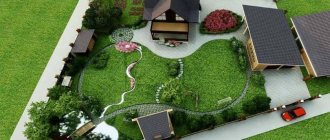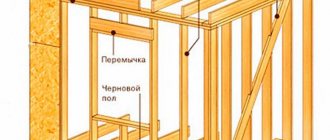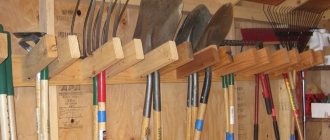Dachas and own houses are increasingly associated with spending quiet or active recreation in nature, rather than with weeding beds and fighting for the harvest. Proper landscape design will help create such an area. And to create it, it is not at all necessary to hire expensive specialists and make the territory most similar to a picture from a fashion magazine. It’s quite possible to create a comfortable and cozy site design yourself.
Brief overview of the article
- Basic Rules
- Landscape Design Styles
- Regular style
- Irregular style
- Country style
- Japanese style
- Chinese style
- Modern
- High tech
- Section division
- Site zones
- Design of the main elements
- Design of secondary elements
- Photo of landscape design of a summer cottage
Basic Rules
The landscape design of the house and the entire territory should be in the same style or complement each other.
Identical elements located in different parts of the site will make the area more harmonious and holistic for perception.
Simplicity of design becomes the basis for creating a pleasant and comfortable place in all respects. Each building or smaller element must find its place in terms of ease of use and harmonious appearance.
The smooth transitions of lines will help create the illusion of more space; a small amount of bright colors will give the opportunity to rest the eyes and nerves, shaken by the stress of the big city.
To create such a light design, avoiding massive buildings and high fences, using natural materials and green hedges will help.
Although modern landscape design styles are still aimed at minimalism in everything, including the number of plants.
Herbs and flowers in creating spectacular landscapes
The main element of almost any garden is the lawn, which serves as a lush green background for other objects.
Flowers add brightness and beauty to the landscape. They are planted in the form of luxurious flower beds and flower beds, focusing on the principles of harmonious unification and combination.
- A flowerbed is a flower garden of regular geometric shape, mainly created from herbaceous perennials and annual crops;
- Border - the framing of paths, beds, flower beds in gardens, created from low-growing flowers of the same species;
- Arabesque - fancy patterns of flowers or a flowerbed of an unusual winding shape;
- Monogarden is a separate area in the garden reserved for growing one type of plant (rosary, peony garden, gladularium, lilinarium, syringarium, floxarium, dahlia, iridarium);
- Rabatka - a bed along the garden, path, building;
- Mixborder is an oblong-shaped flower garden that combines a variety of plants.
Landscape Design Styles
Landscape design ideas are as varied as apartment design styles. Only a larger area provides more space for the implementation of the ideas and wishes of the owners. The style of the site depends solely on the wishes of the owners, their financial capabilities, the availability of free time for maintenance and the size of the territory. Over the more than 200-year history of this art direction, a huge number of styles of private courtyard design have been created, but most owners choose the future design from the main seven types.
Portfolio
Typically, a specialist is evaluated based on photographs of finished projects. But before you agree to cooperate or refuse, consider the following points.
- Not all projects are posted on the site. This means that you may not be able to see the most interesting landscapes from the point of view of landscaping or landscaping. Not every customer is ready for a public display of their possessions.
- It is difficult to estimate the amount of work carried out from photographs. It would be good if there was a detailed description. This way you can understand the designer's capabilities.
In any case, a personal meeting is required, at which a specialist will tell you in detail about the implemented projects and answer your questions.
Regular style
This design is more suitable for large areas (more than 15 acres) and will require additional time. The main idea will be to demonstrate the superiority of man over nature. To do this, they use the principles of strict geometric shapes and regularity of lines, absolute symmetry.
In this design, even flowers must bloom at a strictly defined time. The centerpiece of the design is usually a large lawn or fountain. Sculptures, topiaries, forged arches and strict pergolas are used as decorations.
The prototype of this design is considered to be the royal palaces of France or the more familiar Peterhof.
Irregular style
This option is the complete opposite of the French style. Most of all, it should resemble small English estates, creating the impression that a person has simply moved into an area suitable for comfortable living.
There is no room for straight lines, everything is smoothed out and slightly asymmetrical; shrubs, flowers and trees give the impression of having grown independently in the most spectacular places. They can give the impression of the slightest carelessness, as if the owner was about to trim them, but was distracted by more important matters.
The only completely well-groomed place will be a perfectly flat lawn.
To embody the style, you don’t need to go beyond the borders. A cozy design can be created on 6 acres.
Plant selection
To decorate the site, it is necessary to use coniferous plants that fit most harmoniously into any landscape. It is coniferous specimens that are able to emphasize the beauty of perennial flowers and shrubs that are planted next to them.
A mixborder is a limited space in which conifers and perennial flowering plants grow. Such flower beds attract gardeners with their continuous flowering throughout the year.
What to consider when selecting coniferous plants
Coniferous flower beds with perennials are the best option for decorating a site, since these plants require minimal care. At the same time, they retain their beauty and attractiveness at any time of the year.
When choosing conifers for compositions, you should take into account the width of their growth and the difficulty of care. In one mixborder it is necessary to select specimens that can withstand the same conditions and prefer soil with the same characteristics.
It is important that the plants adjacent to them can also grow in the same conditions, on the same soils.
Division of coniferous plants into families:
- Pine - fir, spruce, cedar.
- Cypress - thuja, juniper, cypress.
- Yew - yew, torrey.
Here is one of the successful composition options with coniferous plants:
- dwarf spruce;
- creeping juniper;
- low-growing representatives: thuja, fir, pine.
Tall species of conifers
The composition of coniferous plants must contain at least one tall specimen. Planted in the center of the flowerbed, it will set the tone for the entire plant ensemble. Around a tall tree you can plant shrubs and groups of perennial flowers.
When creating an emerald lawn, for example, you can choose Hoopsie spruce for the central part of the composition.
Spruce with blue needles will decorate any composition. It grows up to 10 meters in height, spreading its crown 4 meters wide. Not afraid of frost, not picky about the soil.
Thuja Brabant, growing up to 3.5 meters, can “lead” the mixborder along the fence. The tree is evergreen with a narrow pyramid-shaped crown.
The lower branches grow at ground level, covering all unsightly buildings. With Brabant, hedges are often formed and beautiful alleys are created.
Korean fir in nature can grow up to 12 meters. Grows well in the shade, but prefers fertile soil and timely watering. As soon as the tree reaches a meter in height, violet-purple cones appear on it.
Serbian spruce is an unpretentious tree; in nature it grows up to 45 meters. Attracts attention with the beauty of the needles and the color of the cones. There is a large selection of varieties to create a composition. The tree is not afraid of frost and can grow in the shade.
The Skyrocket juniper or pencil tree attracts the attention of gardeners with its unusual proportions. The branches form a narrow columnar crown, which is suitable for creating a composition of coniferous trees. Grows up to 7-8 meters.
Thuja Smaragd grows in the form of a cone up to 5 meters in height, and the crown is only 150 cm wide. It loves sunny areas and regular watering. Can live 100 years.
The tallest thuja is the thuja foldata. A giant tree in nature can grow up to 60 meters. The volumes in diameter are also impressive - 2.5-3 meters. It got its name for its thick, dense crown, where bright green needles overlap each other like scales.
At home, her height is 13-14 meters. Thuja foldata is a real long-liver. Live in one place for 800 years! Adapts to all conditions and grows well.
Medium-sized plants for coniferous compositions
A mixborder of conifers, which are called medium-sized, will look very original if dwarf trees and flowers grow in the neighborhood.
Konika spruce is good because it does not require cutting. Growing up to 2 meters, it has a perfect cone. Thick soft needles of soft green color stand out beautifully against the background of other trees.
Prefers sunny places. Grows well on slightly acidic and neutral soils.
The dacha will quickly acquire a well-groomed appearance if you plant the fast-growing Green Carpet juniper in the flowerbed. In 9-10 years it will grow to 200 mm, spreading its branches 150 mm. The branches are so intertwined with each other that a fluffy “cap” is obtained. Can grow in partial shade on calcareous and sandy soils.
Compacta Glauka pine with a dense pyramidal crown is suitable for stone mixborders and alpine slides. It grows by 80-150 mm annually. Pine grows well in moderately acidic soils.
Thuja Aurea Nana orientalis reaches a height of 170 cm. It attracts attention by changing its color. During the warm season it becomes golden-green, and in winter it acquires a bronze tint.
Barry spruce has a spherical shape. By the age of 25, the tree grows to only 200 cm. It grows well on sandy and loamy soils. Will decorate any coniferous mixborder.
Canadian yew, up to 2.5 m high, has a pyramidal shape. You can give it any shape with a haircut. Unpretentious, but the needles are toxic. When cutting hair, you must wear gloves.
Low-growing and creeping conifers
Any coniferous corner will be decorated with creeping and low-growing conifers.
Thuja Caespitosa grows only up to 40 cm. It is famous for the fact that over time it acquires an unusual semicircular shape in the form of a “pad” of thick light green needles.
With mountain pine, Mini Pug can carry out various experiments, creating different shapes by cutting it. Loves illuminated places, looks good on alpine slides.
Thuja Amber Glow is a spherical shrub valued for its golden color. If grown in the shade, the color will change to green.
The creeping juniper Plumosa will perfectly decorate a coniferous corner. Shoots from the trunk grow 2.5 meters, filling everything around. Can grow in any meta and is completely unpretentious. In the shade, green leaves turn into light green.
The cross-paired microbiota is represented by cypress, the new shoots of which are covered with needles in the form of needles. As the needles grow, they turn into scales. In summer the bush is dark green, and in winter it is copper-brown. Microbiota can develop even in the shade and on rocky soils.
The decorative creeping juniper Golden Carpet is endowed with an unusual color. The upper part is covered with golden needles, and the lower part is covered with yellow-green ones. To see the unusual effect, it must be planted in a sunny area.
The weeping Lorelei spruce begins to creep along the ground after grafting. The shoots first rise beautifully to 60 cm, then fall and spread across the flowerbed, creating a beautiful fluffy carpet.
Creeping Canadian hemlock will help you create a beautiful mixborder. By the age of 10 it grows to 500 mm. Does not withstand drought, prefers partial shade and moist, slightly acidic soil.
Thuja Hoseri has the shape of a ball, which is why it stands out in landscape design. In summer, the thuja is covered with green needles, and in the fall they change to a bronze-brown tone. Young trees need shelter before the winter cold.
Country style
Country is still the most popular style. Bright and elegant, it is subject to the principles of simplicity and ease. For the most part, there are no specific rules in country styles; they are invented by the site owners themselves, based on a reasonable combination of all items.
For such a design, household items (buckets and wheelbarrows as flower beds, a haystack, a fence or a “forgotten” rake), homemade crafts, and creations made of wood and stones are ideal.
The style gives the impression of the best features of country life and has several varieties, of which the most popular remains the soft lilac Provence with its herbs and abundance of flowers and hand-made decorations.
The Moorish style will amaze with bright colors of decoration and a riot of plants, the Mediterranean style will transport you to the charming bliss of a hot afternoon on the seashore, the colonial style will combine a small vegetable garden and comfortable relaxation in a house or recreation area near a pond.
How to create
After the snow melts, the area is cleared
from last year's fallen leaves and dried grass using a rake. To avoid harming wild plants, the lawn is mowed in late autumn, when the flowers have withered and the seeds have ripened. Parterre grass lawns are intended for games, picnics and leisure activities. They are created to be admired in areas made in a classical style, so they must be without the slightest flaw.
Soil preparation and arrangement of the drainage system for lawns must be of high quality, in accordance with the developed technology. Due to this, the cost of the device will be higher. In some cases, one type of flowering plants is grown in the designated area: rosaries, dahlias, gladularia. Arabesques are flower beds of complex shapes that can be presented in the form of insects, birds, animals and ornaments.
Modular compositions differ from them, which consist of strict geometric shapes filled with flowers and paved walking paths. Along the edges of the alleys, a ridge plant is planted in one or several rows. Japanese stone gardens look great, the main elements of which are large boulders overgrown with moss and located on a sandy or gravel area. Grassy lawns and low shrubs with dense foliage complement the landscape of the summer cottage with separate islands.
The original flower garden is the rockery, which is a composition of plants with a central element in the form of a stump with branched roots, driftwood or a thick dry branch. To add mystery, garden figurines of fairy-tale gnomes are installed in secluded places.
A rock garden is a flower garden that is independently organized on an area with uneven terrain, imitating a mountainous area using stones, flowers and low-growing trees.
The same elements include rockeries. Imitating rocky terrain is not an important parameter for them, and some of their areas have clear boundaries and are filled with sand or the most suitable colored material. Designers also highlight the design using gabions - flower beds made of woven mesh.
Rolled lawns are special mesh fabrics that are laid in layers of turf with pre-sprouted grass. This type of lawn has the following advantages:
- They take root quickly;
- Unlike a classic lawn, a rolled lawn does not require post-sowing care, since this stage has already been completed;
- Frees you from the hassle of choosing lawn grass to create a green lawn.
There are a large number of varieties of lawns and grass mixtures with which they are sown. In a suburban area, you can create your own individual lawn using your imagination. For example, if you sow a lawn with shamrock clover, it will turn out quite attractive. The clover lawn blooms with small spherical flowers and requires practically no attention.
Suitable for active owners...
design of a miniature football field on which you can play tennis or badminton. Children will use it for outdoor games or just lying on the green carpet.
Japanese style
The landscape design of the courtyard in the Japanese style stands out from all other ethnic designs. Here, each item is located in a clearly defined place and carries a certain meaning.
It is necessary to have water and stones, a place to contemplate nature and get to know yourself. The style is distinguished by its apparent asymmetry, but at the same time creates an amazing impression of harmony and simplicity.
Modern
The main goal of this design will be the combination of natural principles and modern embodiment. The style is characterized by the rigor of natural lines, the naturalness of the colors used, the functionality and thoughtfulness of each element.
High tech
Modern styles are subordinated to the ideas of minimalism in everything.
Clear paths will lead owners exactly where they wanted to go, without any deviations along the way, using no more than three colors will help calm the eyes and nerves, modern technologies are designed to make life convenient with a minimum amount of resources expended.
Flowers and shrubs are small in size and there are relatively few of them.
Section division
A landscape design project will help you create a suitable area. To distribute the land plot, the following figures are used: no more than 5% will be allocated to the front entrance area, 15-20% will be occupied by the recreation area, about 10% will have to be allocated to buildings, and the garden area will require 70% of the area.
All these figures are approximate and may change depending on the wishes of the owners.
Lighting systems
Garden lighting systems can be basic or decorative. In the first case, fairly bright lamps illuminate the entrance to the house, paths in the garden, barbecue area and children's playground. In the second case, designer lighting of small architectural forms, arches, fountains and waterfalls is used. For all lighting systems, it is best to use LED lamps.
Despite their high cost, LED lamps consume little energy, are durable and safe because they do not heat up during operation.
Site zones
To create a comfortable living area you will need a house, a garage, a kitchen, and a toilet.
The recreation area will have a summer kitchen with a dining room, a gazebo or terrace, a swimming pool or sauna, a lawn, a hammock or a sun lounger.
In the children's area you can arrange a small cozy playground with a swing, a sandbox, and a house.
The green area is represented by a garden and a vegetable garden. Flower beds and flower beds will be a beautiful decoration or frame for any area.
Space zoning
No matter how large the territory of your site is, when arranging the landscape, always focus on the visual expansion of the space. Agree, a spacious garden is a luxury that not everyone can afford. Take advantage of the opportunity through proper zoning to visually enlarge the area and at the same time reduce its maintenance needs.
In this matter, it is important to observe moderation: with excessive division into zones, there is a high probability of losing the integrity of the structure, turning the garden into an absurd set of completely unrelated elements.
| When working with zones, first of all pay attention to natural or closed obstacles between buildings. As a rule, such areas are perfect for arranging flower beds and fountains, walkways and play areas. |
After solving the issue with small zones, move on to larger sites. They must have a clear form and be not only beautiful, but also functional. At this stage, pay great attention to choosing the optimal distance between each of the future zones and the house. So, a recreation area can be placed next to a residential building, and a playground further away. The most remote areas should be agricultural and vegetable garden zones.
Design of the main elements
The house most often sets the style of the entire site. Creating a mood depends on it. For small areas the structure is located in the entrance area; for large areas it can be moved deeper.
Utility buildings are hidden either in the backyard or placed on the far border of the site (except for the garage).
Gazebos will become a pleasant place for owners or guests to relax. Usually there is a barbecue area with a barbecue or tandoor grill or a summer kitchen nearby.
Fences and paths
The zoning of a site can be considered correct only if the general view is gradually revealed to the visitor. This concept can be implemented in different ways; the most effective is the arrangement of one central alley or path with branches on both sides in the form of small paths. If the width of the plot allows, you can build a double alley, separated by a stream or flowerbed. But you shouldn’t place main passages next to the fence.
The paths must be highlighted by shape or color. If the plan provides for the arrangement of paths of different functional meanings and types, they must be visually separated:
- It is better to design the main passages with continuous paving; they should also have sufficient width and borders.
- Secondary paths are smaller, unpaved or paved with gaps.
To zone a site, it is advantageous to use solid translucent fences that do not reveal the general view to the visitor, but also do not force them to contemplate only one particular zone. In this case, an excellent solution would be a cascade technique, which involves increasing the height of the fences as you move away from the entrance area.
Do not forget about observing the general style, compatibility of colors, materials, textures. Natural stone paving looks good in company with a wooden garden house, concrete paths emphasize the laconic beauty of a red brick fence, fences with stainless handrails will create a stylish ensemble with a modern ceramic facade. Try to avoid ridiculous combinations!
Design of secondary elements
Garden paths are one of the important parts of proper design. They not only provide passage to the right place, but also become zone boundaries or a charming decorative element. The materials used are stone, brick, concrete, plastic, grass, crushed stone.
Fences and internal railings will gracefully highlight the chosen style if they are chosen correctly. Very often they are decorated with border flowers, hanging flower pots, and vines.
In small areas, high solid fences should not be used, and it is better to decorate existing partitions of this type with flowers or trees. In this case, it will be possible to visually increase the space.
Ponds will give the area a feeling of additional coolness and create a cozy place to relax. This could be a small pond with herbs around the edges, a swimming pool, or a charming dry stream making its way through the area.
Flower beds will fill the area with different colors and attract beneficial insects. Depending on the chosen style, mixborders, ridges, parterres, arabesques, and rockeries can be used.
Lawn is used to fill large areas. Depending on its purpose, it can be used as a recreation area or used for purely ceremonial purposes.
Decorative elements will help make the area a more “live” and natural place. Such elements include garden figurines and figurines, homemade crafts made from wood or scrap materials, garden and stationary lanterns.
Photos of landscape design will help you decide on the choice of style and design components or come up with something new based on your favorite elements.
Sequence of work and guidance for the future
Among other nuances, you also need to remember that creating landscape design is largely a work for the future. For example, any flower garden or flower bed will be able to take on its proper appearance only two to three years after planting. Remember this at every stage, carry out all work according to a pre-drawn plan. Speaking of sequence: it is advisable to formalize it in the form of a separate planning solution - for convenience and understanding of the processes being performed.
- Work on creating landscape design begins with the dismantling of unnecessary elements, preparing the territory for the placement of new stationary objects - fences, arches, gazebos, ponds, etc.
- After this, a network of paths and paths is formed. They will be used to move people around the territory, as well as for effective zoning of the site. To do this, you will have to think through the main routes, otherwise, access to some important objects may be either impossible or seriously difficult.
- The final stage is a detailed study of individual objects and zones. This includes a fairly extensive scope of work related to landscaping, the formation of natural and artificial fences, decoration of territories, arrangement of reservoirs, recreation areas, reservoirs and other objects included in the project. In this case, the general style and color scheme of the landscape design must be taken into account.


